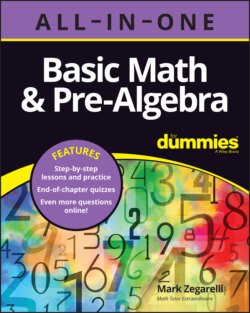Читать книгу Basic Math & Pre-Algebra All-in-One For Dummies (+ Chapter Quizzes Online) - Mark Zegarelli - Страница 17
Composing yourself with composite numbers
ОглавлениеSome numbers can be placed in rectangular patterns. Mathematicians probably should call numbers like these “rectangular numbers,” but instead they chose the term composite numbers. For example, 12 is a composite number because you can place 12 objects in rectangles of two different shapes, as in Figure 1-2.
© John Wiley & Sons, Inc.
FIGURE 1-2: The number 12 laid out in two rectangular patterns.
As with square numbers, arranging numbers in visual patterns like this tells you something about how multiplication works. In this case, by counting the sides of both rectangles, you find out the following:
Similarly, other numbers such as 8 and 15 can also be arranged in rectangles, as in Figure 1-3.
As you can see, both these numbers are quite happy being placed in boxes with at least two rows and two columns. And these visual patterns show this:
© John Wiley & Sons, Inc.
FIGURE 1-3: Composite numbers, such as 8 and 15, can form rectangles.
The word composite means that these numbers are composed of smaller numbers. For example, the number 15 is composed of 3 and 5 — that is, when you multiply these two smaller numbers, you get 15. Here are all the composite numbers from 1 to 16:
Notice that all the square numbers (see the section, “Getting square with square numbers”) also count as composite numbers because you can arrange them in boxes with at least two rows and two columns. Additionally, a lot of other non-square numbers are also composite numbers.
